calsfoundation@cals.org
Venomous Snakes
Arkansas hosts about forty-five species and subspecies of snakes, and six (thirteen percent) are species that use venom to obtain food and to defend themselves. There are two families of venomous snakes in the state: Elapidae (a single elapid species, the Texas coral snake) and Viperidae (five species of pitvipers). All of Arkansas’s venomous snakes inject venom through fangs via muscular contraction of paired venom glands.
Texas Coral Snake
The Texas coral snake, Micrurus tener tener (formerly Micrurus fulvius tenere) is a tricolored, medium-sized (maximum length = 122 centimeters), secretive elapid snake that primarily occurs in the southern and southwestern part of the state. Verified records are available for only five counties of the state in the Gulf Coastal Plain, including Columbia, Lafayette, Nevada, Ouachita, and Union; questionable “sight” records exist from Hempstead and Miller counties. It inhabits forested (mixed hardwood and pine) habitat and appears to prefer dry, sandy areas. This snake prefers hiding in old stumps, decaying logs, and debris piles, and it spends much of its time underground in organic leaf litter. The Texas coral snake is a predator that feeds primarily on small terrestrial colubrid snakes and skinks. However, they have been known to be cannibalistic, as well as feeding on other venomous snakes such as copperheads. Predators include other snakes such as the speckled kingsnake, Lampropeltis holbrooki. Texas coral snakes lay from two to twelve eggs in May and June, and hatchlings appear later in the summer.
Although the Texas coral snake is relatively docile and rarely bites when handled or disturbed, it should be treated carefully, as it possesses a potent and sometimes lethal neurotoxic venom. Indeed, this snake is very dangerous to humans and, undoubtedly, has one of the most lethally potent venoms of any North American serpent. The body of this snake is encircled by multicolored red, black, and yellow/white rings, with the red and yellow rings always coming in contact with each other. There is a rhyme that some people use when seeing any snake in North America with similar coloration (to reliably differentiate dangerous snakes from coral-snake mimics such as milk snakes and scarlet snakes): “red touches yellow, kill a fellow, red touches black, friend of Jack.” Outside the United States, however, such as in Mexico (south of the latitude of Mexico City), Central America, and South America, coral snakes have distinctly different coloration and patterns.
The status, ecology, and natural history of the coral snake in Arkansas are not known, and what is available about the species has been taken mostly from studies conducted in Texas. However, with its narrow range in the state, continued destruction of suitable habitat using clear-cutting techniques as well as alteration of forested habitat could make this snake vulnerable to extirpation in the state.
PITVIPERS
There are five venomous pitvipers in Arkansas. They possess a heat-sensing (loreal) pit located behind each nostril that can detect differences in temperature given off by an animal to help determine if it is predator or prey.
Southern Copperhead
The southern copperhead (Agkistrodon contortrix contortrix) is perhaps the most common viperid seen in the state. It is a regally patterned medium-sized (maximum total length of 132 cm) stout snake that is found nearly statewide. This snake possesses a series of ten to eighteen distinctive dark brown, beige, or orange/tan hourglass-shaped dorsal crossbands, although there is some variation in body patterns. Although it is listed as being statewide in geographic distribution in Arkansas, records are lacking for a handful of Arkansas counties. It occurs in a wide variety of environs ranging from upland to lowland habitats in deciduous and coniferous forests and dry rocky hillsides to damp woodlands. They have been found occupying old dump sites, homesteads, fields, and riparian sites where they seek shelter under decaying logs, railroad ties, tin roofing, and old lumber. In addition, there are records of A. c. contortrix from caves as well as abandoned mine shafts in Arkansas. They appear to be especially common in some counties along Crowley’s Ridge southward into the Delta agricultural region of the state. Morphological intergrades of A. c. contortrix × A. c. phaeogaster (broad-banded copperhead) have been reported from Benton, Carroll, Clay, Garland, Hot Spring, Grant, Greene, Lawrence, Madison, Marion, Pike, Polk, Sebastian, and Washington counties.
Ecological studies on southern copperheads have been conducted on populations primarily in the northeastern part of the state. Eighty-six percent of adult females examined in Arkansas were reproductively active. Copperheads give birth to live young, and there are from five to six young in an average litter. The southern copperhead is one of the most abundant venomous snakes in Arkansas. For example, during a two-month period in 1933, fifty A. contortrix were killed at a lumbering operation near Paragould (Greene County).
Adult copperheads are ambush predators, whereas young may actually seek out prey. Several prey items are included in their diet, including small mammals, lizards, snakes, insects, and other arthropods. In Arkansas, larval cicadas were taken via arboreal foraging in Madison County, and a variety of rodents (mostly voles, Microtus sp.) were found in the stomach contents of specimens from northeastern Arkansas. In addition, an eastern mole (Scalopus aquaticus) was eaten by an A. c. contortrix in Polk County. They possess small fangs and a hematoxic venom that, although the fatality rate is quite low for bites from this snake, accounts for the majority of envenomations in the United States. Contrary to widespread belief, newborn snakes may actually possess more-potent venom than adults.
Western Cottonmouth
The western cottonmouth (also commonly called a water moccasin), Agkistrodon piscivorus leucostoma, is a relatively large (maximum length 158 cm), heavily bodied, semiaquatic viperid that occurs throughout most of Arkansas. Although it is considered statewide in distribution, records are lacking from upland streams of the Ozarks in Boone, Fulton, Izard, Marion, and Sharp counties, and in the southwestern part of the state in Howard County. The highest elevation for which any A. p. leucostoma has ever been found is atop Rich Mountain in Polk County, at 762 meters (2,500 feet). The adult’s coloration is mostly black, dark brown, or olive with an inconspicuous pattern of ten to fifteen dark transverse crossbands on the dorsum. However, a juvenile cottonmouth bears little resemblance to the adult, and is sometimes mistaken for a young copperhead. This snake is found in almost any sort of watershed, including rivers, streams, creeks, bayous, swamps, lakes, marshes, and ponds. They appear to prefer sites with vegetated shoreline and areas for basking such as log jams, brush piles, exposed rocks, and rip-rap.
In Arkansas, there have been few studies on the cottonmouth, although there are scattered reports on various aspects of its natural history. Examination of female reproduction in the western cottonmouth reported an average litter size of five neonates. Not all female cottonmouths breed every season, however, and thirty-three percent of those examined were non-reproductive.
Western cottonmouths are ambush predators that feed on a variety of vertebrates, including amphibians, fish, frogs, water snakes, small mammals, and birds. Examination of twenty western cottonmouths from the Ouachita Mountains of Arkansas and Oklahoma reported four stomachs containing Ouachita dusky salamanders, Desmognathus brimleyorum. In addition, another was reported to scavenge a dead yellowbelly watersnake (Nerodia erythrogaster) near Newport (Jackson County), and predation on watersnakes has been reported for this species elsewhere.
Unlike the copperhead, the cottonmouth is an ill-tempered, unpredictable, very dangerous snake with large fangs. When cornered, it will stand its ground, coil, and gape its mouth to reveal an inner white lining (from which comes the name cottonmouth). It possesses potent hemotoxic venom with pronounced hemorrhagic effects such as those capable of destroying erythrocytes, rupturing capillaries, and damaging tissues. In addition, it is known to produce neuromuscular block.
Western Diamondback Rattlesnake
One of the three rattlesnakes in the state, the western diamondback rattlesnake (Crotalus atrox) is a heavily bodied species and the second-largest viperid in the United States. It attains a maximum length of 234 cm, while the largest specimen from Arkansas was 173 cm, collected from Conway County on Petit Jean Mountain. This snake is conspicuous and exhibits rhomboid or diamond-shaped blotches down its dorsum, and each is bordered by a single row of white scales. In addition, possession of a rattle will almost always identify a snake of this group unless the entire tail tip, including the rattle, is missing as a result of injury.
There are spotty records of the western diamondback rattlesnake in the state, with specimens coming from the following central and western counties: Conway, Garland, Hot Spring, Johnson, Logan, Miller, Montgomery, Perry, Pike, Polk, Pulaski, Saline, Sebastian, Washington, White, and Yell. It inhabits dry, rocky habitat characterized by exposed rocky escarpments, rocky glades, and talus slides.
Little is known about the ecology and natural history of C. atrox in Arkansas. Much of the earlier literature from the state on this snake was authored or coauthored by Richard Marlin Perkins (1905–1986), best known as a host of the television program Mutual of Omaha’s Wild Kingdom. He provided information on their habitat, spring activity, and courtship. In addition, he collected ten C. atrox on Rattlesnake Mountain in Saline County. Nothing is available about western diamondback rattlesnake reproduction in Arkansas. Females are thought to give birth to live young in Arkansas in September, and in other parts of their range in Texas from August to October, with litter size ranging from four to twenty-five.
Crotalus atrox feeds primarily on various mammals, including shrews, rodents, and rabbits. In one major study in Texas, woodrats (Neotoma spp.) were this snake’s favorite prey, followed by pocket mice (Chaetodipus spp.). However, lizards, bird eggs, amphibians, and lubber grasshoppers have also been reported in the diet of this snake. Predators include a variety of larger mammals (deer, wild hogs, coyotes, foxes, bobcats); birds such as hawks, owls, and roadrunners; and snakes, including kingsnakes and coachwhips.
This snake is the most dangerous species in Arkansas and should be treated as such. A typical case of envenomation by C. atrox shows extreme pain at the victim’s bite site with swelling progressing along the bitten limb toward the body. A bruise-like discoloration with concomitant blistering and ecchymosis soon appears at the bite and may involve the entire bitten area. Physiological symptoms include increased pulse rate, hypotension, weakness, sweating, faintness, dizziness, and sometimes nausea and vomiting. Death, if it occurs, usually happens within six to twenty-four hours after the bite from a drop in hemoglobin, abdominal bleeding, hemorrhaging of major organs, and acute pulmonary edema.
Timber (or Canebrake) Rattlesnake
The timber (also called canebrake) rattlesnake, Crotalus horridus, is another extremely dangerous pitviper in the state. It is a large, heavily bodied snake that attains a maximum total length of 189 cm; the largest specimen from Arkansas measured 132 cm. The adult dorsal color and pattern is quite variable but is mostly pale gray or tan with nineteen to thirty dark V-shaped crossbars and an orange to reddish-brown mid-dorsal stripe and black tail. It is reported to occur statewide, although twelve county records (Ashley, Boone, Clark, Cleburne, Conway, Miller, Hempstead, Howard, Jefferson, Johnson, Searcy, and Van Buren) have not yet been documented. A variety of habitats support populations of this snake, including south-facing rocky outcrops, upland hardwood forests, brushy fields, and pine plantations as well as forested floodplains and swamps. Interestingly, a population of C. horridus was found in October 1992 at a rock outcropping within Crater of Diamonds State Park in Pike County; this site was previously known for having large numbers of this snake.
This snake breeds in the fall or early spring, and seven to seventeen young/litter are born in August through October. It feeds on insects, frogs and toads, lizards, shrews, rodents, rabbits, and ground-nesting birds. Predators of this snake are similar to those for the western diamondback.
Although this rattlesnake has a relatively mild disposition and is reluctant to strike compared to the western diamondback, it is a highly venomous and dangerous snake that possesses very long fangs (up to 10 mm), a considerable striking range, a substantial venom output, and a strongly hemotoxic venom. Although unusually toxic venom has been reported in some populations of C. horridus, there is a certain degree of variation in the toxicity within a given snake population. In addition, venom from juvenile specimens of timber rattlesnakes has been reported to be more toxic than that of the adults. Human fatalities from envenomation by timber rattlesnakes have been reported, and the effects on people bitten by the snake are similar to those of C. atrox.
Western Pigmy (or Ground) Rattlesnake
The western pigmy (or “ground”) rattlesnake (Sistrurus miliarius streckeri) is Arkansas’s smallest rattlesnake (up to 64 cm total length). It is gray with twenty-three to thirty-five black blotches or crossbands down the dorsum and a rust-colored mid-dorsal stripe. Although the head is boldly patterned, crossbands are usually incomplete, with gaps along the sides of the body. This snake is reported to occur statewide in Arkansas; there are records for nearly half the counties, but numerous counties, including several in the upper Arkansas River Valley and Mississippi Alluvial Plain, lack specimen records. It occurs in rocky habitat, mixed hardwood-pine forests, pine plantations, palmetto-hardwood forests, and cedar glades as well as marshes, cropland, and brushy areas along the Red River in the southwestern part of the state.
There is a lack of information on the life history of this rattlesnake in Arkansas. An average litter size is six to fourteen young, and they are born in August and September. This snake is an ambush predator that feeds on a variety of invertebrates (centipedes, insects, and spiders) and vertebrates, including frogs, rodents, lizards, birds, and small snakes. For example, a four-toed salamander (Hemidactylium scutatum) was found in the stomach of an S. m. streckeri from Garland County. Predators of western pigmy rattlesnakes include kingsnakes, hawks, opossums, skunks, and domestic dogs and cats.
The western pigmy rattlesnake does not have a very toxic venom compared to Arkansas’s other rattlesnakes; however, it still should be treated with care. It is difficult to be forewarned of its presence on the ground because of its coloration and because of its hard-to-hear rattles that sound like the buzz of an insect. Western pigmy rattlesnakes typically respond to a nearby threat by coiling and vigorously striking. Statistics indicate that snakebites from this pitviper are relatively few, and although they are capable of producing serious effects, rarely are human deaths reported. Envenomation produces moderate to severe localized symptoms such as hemorrhaging, passing bloody urine, and having difficulty in breathing. Unless the victim is very young or old, most recover completely and uneventfully in a matter of days.
Other Mildly Venomous Snakes
Although there are other snakes in Arkansas that are considered mildly venomous, they are of no real concern to humans. The eastern hognose snake (Heterodon platirhinos) is a “rear-fanged” colubrid that has been reported to possess a relatively mild toxin in its saliva. It rarely attempts to bite and prefers to demonstrate an extraordinarily defensive posture of its body known as death feigning. Others that are mildly venomous include those in the genera Nerodia (watersnakes) and Thamnophis (garter and ribbon snakes).
Snakebite Treatment
Snakebites are estimated to lead to as many as 9,000 emergency room visits yearly in the United States; venomous species account for approximately one-third of these visits, almost all of which are pitviper bites. Recent investigators have estimated the incidence of venomous snakebite in the United States at roughly 7,000 to 8,000 per year, with fatalities averaging fewer than ten a year. In Arkansas, statistics documented between 1960 and 2007 by the Arkansas Department of Health noted that only three Arkansans died from snakebites from native species, with all three occurring in the 1960s. One death in 1960 was from a rattlesnake (unknown species) bite, while the other two, in 1964 and 1965, were from bites from an unspecified snake species. Arkansas Children’s Hospital in Little Rock (Pulaski County) typically sees twenty to twenty-five snakebites a year, but some of these might be from nonvenomous snakes.
When compared to other states, North Carolina had the most people who suffered venomous snakebites in a single year (nineteen percent of all venomous snakebites), followed by Arkansas with seventeen percent, and Texas with fifteen percent. Half of all bites occur in the age group eighteen to twenty-eight years, with more men being bitten than women.
Humans have a much better statistical chance of being killed from an automobile accident, a lightning strike, an incidence of drowning, a hunting accident, a bee/wasp sting, or an arachnid bite than being killed by a bite from a venomous snake. However, in the rare event of a bite, a few simple tenets will greatly increase a person’s chance of surviving. A victim should avoid any physical exertion and be transported to the nearest hospital that has antivenin (calling ahead if possible) for prompt medical care. In Arkansas, the Poison Control and Drug Information Center at the University of Arkansas for Medical Sciences College of Pharmacy can assist in finding an appropriate medical facility by dialing 1-800-222-1222. Constrictive clothing or jewelry near the bite should be removed or cut to avoid constriction with subsequent swelling. Use of incision and oral/mechanical suction, placement of a tourniquet or pressure bandaging, application of ice to the bite site, or application of a stun gun or electroshock are potentially harmful and should not be used. In addition, victims should not drink alcohol or use nonsteroidal anti-inflammatory drugs (NSAIDS) like aspirin or ibuprofen for pain. If the snake has been killed and/or a photograph of the snake is available, the snake or photo should also be taken to the medical facility for proper identification since similar-looking nonvenomous snakes can be mistaken for venomous species.
In referring to bites, distinction should be made between a successful envenomation and a “dry bite.” If there are fang marks and a positive identification has been made of a pitviper, the victim must accept there is associated envenomation (no matter how much) and seek medical attention immediately. The absence of local or systemic symptoms eight hours after the bite may indicate a so-called dry bite. Interestingly, snakes can bite reflexively for periods lasting up to one hour after death; for instance, a bite from the severed head of a large timber rattlesnake killed a Florida man. Observing some commonsense safety practices by learning to recognize venomous species in Arkansas, becoming familiar with their ecology, and, most importantly, never handling them, will reduce a person’s risk of snakebite.
For additional information:
Arnold, R. E. Treatment of Rattlesnake Bites. In Rattlesnake Venoms: Their Actions and Treatment. Edited by A. T. Tu. New York: Marcel Dekker, 1982.
Boundy, Jeff, and John L. Carr. Amphibians & Reptiles of Louisiana: An Identification and Reference Guide. Baton Rouge: Louisiana State University Press, 2017.
Burkett, R. D. “Natural History of the Cottonmouth Moccasin, Agkistrodon piscivorus (Reptilia).” University of Kansas Publications of the Museum of Natural History 17 (1966): 435–491.
Bush, Sean P. “Snakebite Suction Devices Don’t Remove Venom: They Just Suck.” Annals of Emergency Medicine 43 (2004): 187–188.
Ernst, Charles H. Venomous Reptiles of North America. Washington DC: Smithsonian Institution Press, 1992.
Ernst, Charles H., and Roger W. Barbour. Snakes of Eastern North America. Fairfax, VA: George Mason University Press, 1989.
Gallaher, Bannon. “Factors That Affect Home Range of Timber Rattlesnakes (Crotalus horridus) in Northwest Arkansas.” MS thesis, University of Arkansas, 2023.
Glass, T. G. “Early Debridement in Pit Viper Bites.” Journal of the American Medical Association 235 (1976): 2513–2516.
Greene, Harry W. “Feeding Behavior and Diet of the Eastern Coral Snake, Micrurus fulvius.” University of Kansas Museum of Natural History, Special Publication 10 (1984): 147–162.
Grogan, W. L., Jr. “Effects of Accidental Envenomation from the Saliva of the Eastern Hognose Snake, Heterodon platyrhinos.” Herpetologica 30 (1974): 248–249.
Hardy, David Lopp. “A Review of First Aid Measures for Pitviper Bite in North America With an Appraisal of Extractor Suction and Stungun Electroshock.” In Biology of the Pitvipers, edited by J. A. Campbell and Edmund L. Brodie III. Tyler, TX: Selva, 1993.
Hawgood, J. B. Physiological and Pharmacological Effects of Rattlesnake Venoms. In Rattlesnake Venoms, Their Action and Treatment. Edited by A. T. Tu. New York: Marcel Dekker, 1982.
Howe, N., and J. Meisenheimer. “Electric Shock Does Not Save Snakebitten Rats.” Annals of Emergency Medicine 17 (1988): 254–256.
Irwin, Kelly J. Arkansas Snake Guide. Little Rock: Arkansas Game and Fish Commission, 2004.
Kannan, Nicholas C., Jeremiah Ray, Matthew Stewart, Katie W. Russell, Matthew Fuller, Sean P. Bush, E. Martin Caravati, Michael D. Cardwell, Robert L. Norris, and Scott A. Weinstein. “Wilderness Medical Society Practice Guidelines for the Treatment of Pitviper Envenomations in the United States and Canada.” Wilderness & Environmental Medicine 26 (2015): 475–487.
Klauber, Laurence M. Rattlesnakes: Their Habits, Life Histories, and Influence on Mankind. 2nd ed. Berkeley: University of California Press, 1972.
Lind, C. M., B. Flack, Douglas D. Rhoads, and Steven J. Beaupre. “The Mating System and Reproductive Life History of Female Timber Rattlesnakes in Northwestern Arkansas.” Copeia 104 (2016): 518–528.
McAllister, Chris T., Stephen R. Goldberg, H. J. Holshuh, and Stanley E. Trauth. “Disseminated Mycotic Dermatitis in a Wild-Caught Timber Rattlesnake, Crotalus horridus (Serpentes: Viperidae), from Arkansas.” Texas Journal of Science 45 (1993): 279–281.
O’Neil, M. E., K. A. Mack, J. Gilchrist, and E. J. Wozniak. “Snakebite Injuries Treated in United States Emergency Departments, 2001–2004.” Wilderness and Environmental Medicine 18 (2007): 281–287.
Parker, Malcolm V. “Notes on the Herpetology of Clay and Greene Counties, Arkansas.” Proceedings of the Arkansas Academy of Science 2 (1947): 15–30.
Perkins, R. Marlin. “Collecting Reptiles near Little Rock, Arkansas.” Bulletin of the Antivenin Institute of America 1928 (1928): 47–50.
Perkins, R. Marlin, and M. J. R. Lentz. “Contribution to the Herpetology of Arkansas.” Copeia 1934 (1932): 139–140.
Price, Andrew H. Venomous Snakes of Texas: A Field Guide. Austin: University of Texas Press, 2009.
Quinn, Hugh R. “Reproduction and Growth of the Texas Coral Snake, Micrurus fulvius tenere.” Copeia 1979 (1979): 453–463.
Roze, Janice A. “New World Coral Snakes (Elapidae): A Taxonomic and Biological Summary.” Memoirs of the Instituto Butantan 46 (1982): 305–338.
Roze, Janice A., and G. M. Tilger. “Micrurus fulvius.” Catalogue of American Amphibians and Reptiles (1983): 316.1–316.4.
Russell, Findley E. Snake Venom Poisoning. Great Neck, NY: Scholium International, 1980.
Russell, Findley E., and Harold W. Puffer. “Pharmacology of Snake Venoms.” In Snake Venoms and Envenomation, edited by Sherman A. Minton. New York: Marcel Dekker, 1971.
Suchard, J. R., and F. LoVecchio. “Envenomations by Rattlesnakes Thought to Be Dead.” New England Journal of Medicine 340 (1999): 1930.
Tennant, Alan. Snakes of North America: Eastern and Central Regions. Rev. ed. Lanham, MD: Lone Star Books, 2003.
Trauth, Stanley E., and Betty G. Cochran. “Life History Notes: Hemidactylium scutatum. Predation.” Herpetological Review 22 (1991): 25.
———. “In Search of Western Diamondback Rattlesnakes (Crotalus atrox) in Arkansas.” Bulletin of the Chicago Herpetological Society 27 (1992): 89–94.
Trauth, Stanley E., R. L. Cox Jr., Walter E. Meshaka, Brian P. Butterfield, and Anthony Holt. “Female Reproductive Traits in Selected Arkansas Snakes.” Proceedings of the Arkansas Academy of Science 48 (1994): 196–209. Online at http://scholarworks.uark.edu/cgi/viewcontent.cgi?article=1953&context=jaas (accessed August 28, 2018).
Trauth, Stanley E., and Chris T. McAllister. “Vertebrate Prey of Selected Arkansas Snakes.” Proceedings of the Arkansas Academy of Science 49 (1995): 188–192. Online at http://scholarworks.uark.edu/cgi/viewcontent.cgi?article=1911&context=jaas (accessed August 28, 2018).
Trauth, Stanley E., Henry W. Robison, and Michael V. Plummer. The Amphibians and Reptiles of Arkansas. Fayetteville: University of Arkansas Press, 2004.
Tumlison, Renn, Mark Karnes, and M. Clark. “New Records of Vertebrates in Southwestern Arkansas.” Proceedings of the Arkansas Academy of Science 46 (1992): 109–111. Online at http://scholarworks.uark.edu/cgi/viewcontent.cgi?article=2091&context=jaas (accessed August 28, 2018).
Weiss, R., and R. J. McIsaac. “Cardiovascular and Muscular Effects of Venom from Coral Snake, Micrurus fulvius.” Toxicon 9 (1971): 219–228.
Zaidan, F., III. “Western Cottonmouth (Agkistrodon piscivorus leucostoma) Sexual Dimorphism and Dicromatism in Northwestern Arkansas.” Herpetological Natural History 8 (2001): 79–82.
Chris T. McAllister
Eastern Oklahoma State College
Henry W. Robison
Sherwood, Arkansas
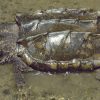 Reptiles
Reptiles Science and Technology
Science and Technology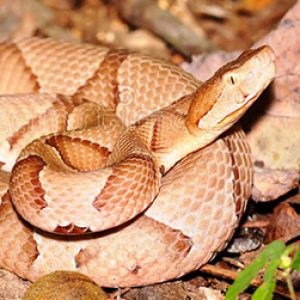 Agkistrodon Snakes
Agkistrodon Snakes 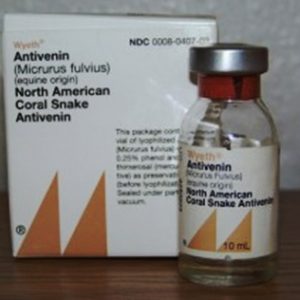 Antivenins
Antivenins 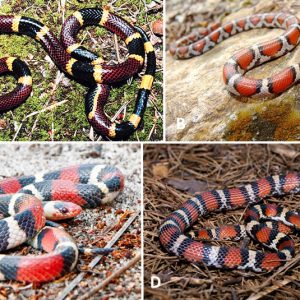 Coral Snake & Mimics
Coral Snake & Mimics 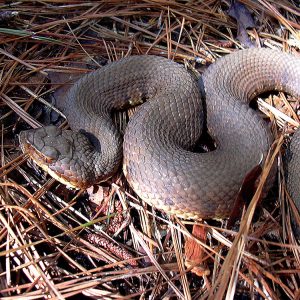 Cottonmouth
Cottonmouth 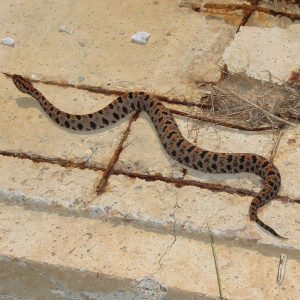 Pygmy Rattlesnake
Pygmy Rattlesnake 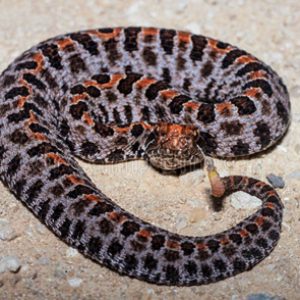 Rattlesnakes
Rattlesnakes 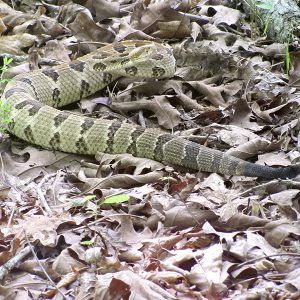 Timber Rattler
Timber Rattler 



Comments
No comments on this entry yet.